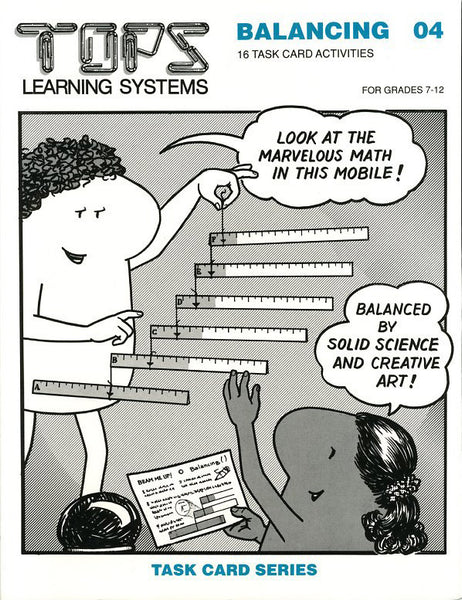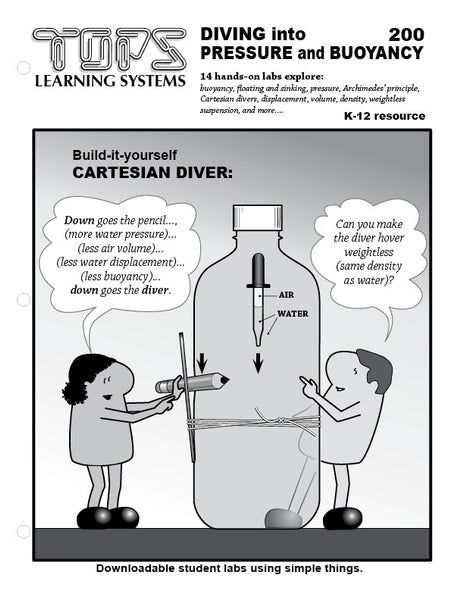Soft-bound, 88 page book, 36 reproducible task cards, full teaching notes.
Scrutinize the particle and wave nature of light: how it reflects, refracts, focuses; how it adds and subtracts color and splits into rainbows. Optical lab equipment usually costs big bucks. Get better results using little more than 2 ordinary hand lenses! Add an extra pair more to model working microscopes and telescopes.
Light Starter Kit
book not included, please order separately
WE SUPPLY in quantities that serve one student or two students working in a lab pair: aluminum foil, waxed paper, mirrors, index cards, 5 heavy-duty D-cell batteries, baby food jar, clear tape, masking tape, straws, canning ring, test tubes, pipette, rubber bands, straight pins, paper clips, thread, microscope slides, hand lenses, flashlight, clear vial
More Information – click any of the tabs below to learn more about this title
Click here for a complete list of materials and convenient shopping.
Key: (1st/2nd/3rd) denote needed quantities: (1st) enough for 1 student doing all activities; (2nd) enough for 30 students working in self-paced pairs; (3rd) enough for 30 students working in pairs on the same lesson. Starred* items may be purchased below.
1/1/1: packet powdered milk (or fresh milk)
1/1/1: source of water
* 1/10/10: baby food jars
1/10/10: dark-colored cloth towels
1/10/10: flashlights with two fresh size-D batteries -- ask students to bring these from home
* 1/1/1: roll aluminum foil
* 1/6/10: rolls masking tape
* 2/20/20: rectangular pocket mirrors without frames
2/20/20: empty tin cans -- medium 15 or 16 ounce size
1/1/1: roll waxed paper
* 4/40/40: medium-sized rubber bands
* 3/30/30: straight pins
1/10/10: scissors
1/10/10: empty cereal boxes
3/30/30: size-D batteries, dead or alive
5/50/50: 4x6 inch index cards
* 5/50/50: paper clips
1/2/5: hole punch
* 1/1/1: spool thread
2/20/20: pennies
10/100/100: sheets notebook paper
* 5/50/50: straight plastic drinking straws
2/6/20: bathroom hand mirrors with plane surfaces
* 4/40/40: microscope slides
1/6/10: rectangular cake pans -- about 9x12 inches
* 1/6/10: eyedroppers
1/4/10: empty tuna cans or equivalent size
* 2/8/20: small test tubes
* 4/40/40: hand lenses with handles
1/4/10: transparent plastic pill vials (optional)
1/4/10: prisms (optional)
* 1/4/10: white plates (or paper plates)
1/1/1: sheets each of blue and yellow cellophane (or transparent report covers in blue and yellow)
2/20/20: textbooks of equal size
1/1/1: roll plastic wrap
1/4/10: ball point pens
* 1/5/10: rolls clear tape
* 1/6/10: canning rings
1/4/10: spoons
1/10/10: facial tissues (soft toilet paper)
Lesson 1: To observe the path of light beams in a colloidal suspension. To understand light beams in terms of the particle nature of light.
Lesson 2: To view an image through a pinhole. To draw a ray diagram that explains why pinhole images are inverted.
Lesson 3: To observe how a pinhole image changes position and size. To explain these variations using ray diagrams.
Lesson 4: To understand why shadows change size when objects are held close to a light source, but remain constant for distant sources.
Lesson 5: To relate the clarity of a shadow to its distance from the light source and screen.
Lesson 6: To model a solar eclipse. To relate the completeness of an eclipse to the kind of shadow it casts on the earth.
Lesson 7: To discover that the angles of incidence and reflection are equal for light reflected by a plane mirror.
Lesson 8: To discover that an object and its mirror image appear equidistant from the reflecting surface of a mirror.
Lesson 9: To predict the position of images behind a mirror by drawing rays and measuring angles. To confirm the accuracy of these drawings by checking their reflections in a plane mirror.
Lesson 10: To diagram where virtual images are formed behind plane mirrors, using the principle that the angle of incidence equals the angle of reflection.
Lesson 11: To create an illusion with mirrors. To explain the illusion using principles of light reflection.
Lesson 12: To use the transmitting and reflecting properties of glass to create visual illusions.
Lesson 13: To examine how water waves in a pan model the behavior of light waves.
Lesson 14: To bend water waves in a ripple tank by slowing them against a shallow bottom. To relate this behavior to the bending of light beams.
Lesson 15: To diagram how an incident light ray is refracted through glass. To account for its direction of bending.
Lesson 16: To predict how the direction and amount of bending of refracted light varies with a changing angle of incidence. To verify these predictions by experiment.
Lesson 17: To understand how refracted light changes the apparent position of an object in water when viewed from above its surface.
Lesson 18: To create concave, planar and convex water surfaces in a test tube. To understand why these shapes produce images of different sizes.
Lesson 19: To interrupt projected light rays with a variety of objects. To interpret the various reflections and refractions that result.
Lesson 20: To identify colors in the visible spectrum. To recognize that these colors are the refracted components of white light.
Lesson 21: To mix colors by subtracting them from white light and by adding them to white background. To distinguish between color addition and subtraction.
Lesson 22: To observe how a hand lens refracts incoming parallel rays to a focal point. To measure its focal length.
Lesson 23: To observe how light from a distant source focuses through a lens at the focal point. To observe a cone of focusing light rays in a jar of cloudy water.
Lesson 24: To classify incident light rays into 5 possible groups and examine how they are characteristically refracted by a hand lens.
Lesson 25: To predict the position of the virtual image of a pin located within one focal length of the lens. To confirm this position by experiment.
Lesson 26: To predict the position of the real image of a pin located outside one focal length of the lens. To confirm this position by experiment.
Lesson 27: To observe how images through a lens change with an object's distance from the lens. To understand these changes in terms of ray diagrams.
Lesson 28: To construct working models of a telescope and microscope from two hand lenses.
Lesson 29: To construct and uses more working models of telescopes and microscopes.
Lesson 30: To observe how increasing lens curvature shortens the focal length. To use this principle to explain how your eye focuses images on its retina.
Lesson 31: To simulate near-sighted vision with a hand lens, and refocus the blurred image with a pinhole. To understand why pinholes keep light in focus at all distances.
Lesson 32: To explore three different ways to magnify the image of a pin. To compare and contrast each method.
Lesson 33: To reproduce a reflected mirror image on paper, using the principle that glass both reflects and transmits light. To study the reversed nature of the reflected virtual image.
Lesson 34: To study symmetry in letters of the alphabet using a plane mirror.
Lesson 35: To study how images are projected by concave and convex mirrors.
Lesson 36: To confirm that concave and convex mirrors produce images as predicted in the previous activity.
We encourage improvisation - it's one of the main goals of our hands-on approach! You and your students might invent a simpler, sturdier or more accurate system; might ask a better question; might design a better extension. Hooray for ingenuity! When this occurs, we'd love to hear about it and share it with other educators.
National Science Education Standards (NRC 1996)
TEACHING Standards
These 20 Activity Sheets promote excellence in science teaching by these NSES criteria:
Teachers of science...
A: ...plan an inquiry-based science program. (p. 30)
B: ...guide and facilitate learning. (p. 32)
C: ...engage in ongoing assessment of their teaching and of student learning. (p. 37)
D: ...design and manage learning environments that provide students with the time, space, and resources needed for learning science. (p. 43)
CONTENT Standards
These 20 Activity Sheets contain fundamental content as defined by these NSES guidelines (p. 109).
• Represent a central event or phenomenon in the natural world.
• Represent a central scientific idea and organizing principle.
• Have rich explanatory power.
• Guide fruitful investigations.
• Apply to situations and contexts common to everyday experiences.
• Can be linked to meaningful learning experiences.
• Are developmentally appropriate for students at the grade level specified.
Unifying Concepts and Processes
NSES Framework: Systems, order, and organization • Evidence, models and explanation • Constancy, change, and measurement • Evolution and equilibrium • Form and function
Core Concepts/Processes: Light behaves both as a particle and as a wave. Both models are required to explain a wide variety of light phenomena. • Law of reflection (angle i = angle r)
Science as Inquiry (content standard A)
NSES Framework: Identify questions that can be answered through scientific investigations. • Design and conduct a scientific investigation. • Use appropriate tools and techniques to gather, analyze, and interpret data. • Develop descriptions, explanations, predictions, and models using evidence. • Think critically and logically to make the relationships between evidence and explanations. • Recognize and analyze alternative explanations and predictions. • Communicate scientific procedures and explanations.
Core Inquiries: Examine how animals survive in specific environments. Can you design a critter that hides in plain sight; that survives a class vote?
Physical Science (content standard B)
NSES Framework: Light, heat, electricity, and magnetism • Structure and properties of matter • Interactions of energy and matter
Core Content: Light as particles • Light as waves • Shadows • Solar eclipses • Reflection • Refraction • Color addition and subtraction • Real images • Virtual images • Inverted images • Concave, planar and convex mirrors • Focal length • Telescopes • Microscopes • Symmetry
Earth and Space Science (content standard D)
NSES Framework: Changes in earth and sky Core Content:Shadows • Solar eclipse
Science and Technology (content standard E)
NSES Framework: k458912 Abilities of technological design • Understanding about science and technology Core Content: Invent working models of a microscope and a telescope using hand lenses in combination.






